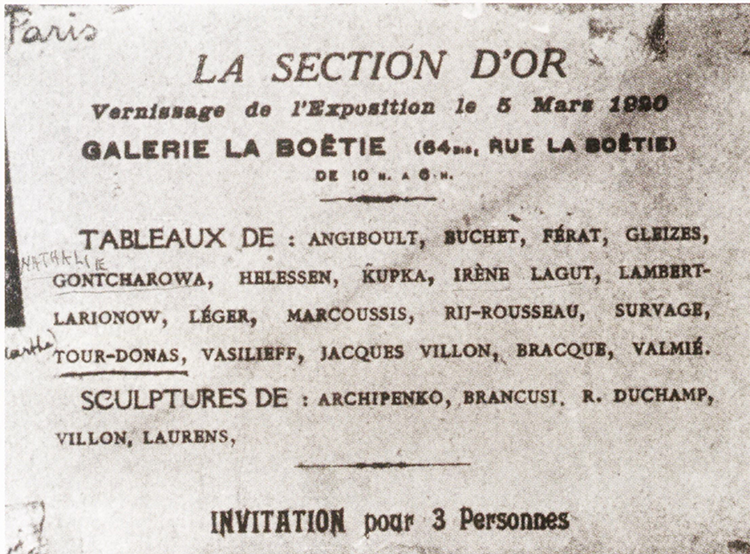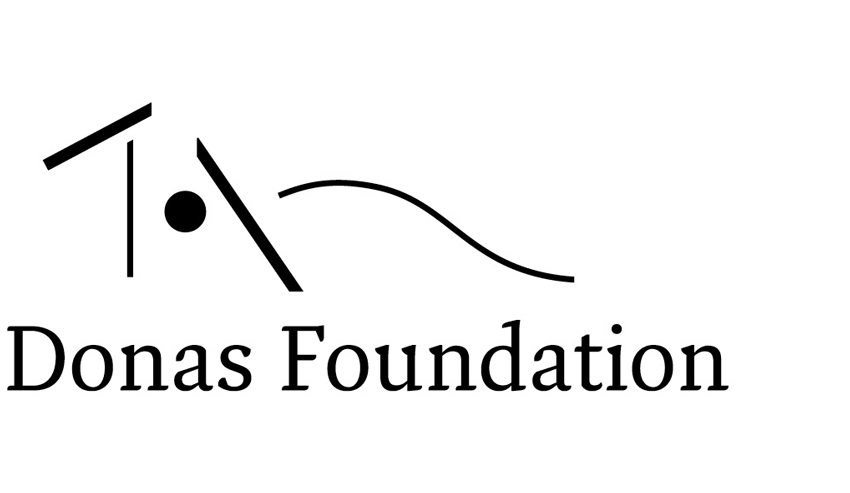

The Belgian artist Marthe Donas, who is gradually being rediscovered internationally, shot to fame in the years around 1920. Her paintings and collages – enigmatically signed ‘Tour Donas’ – hung at the time alongside the leading names of the avant-garde in London, Geneva, Paris, Amsterdam, Berlin, Brussels and Rome and in exhibitions that toured the United States. It was via Paris rather than Belgium, however, that she came to be part of an international artistic network that sprang back into life after the First World War and included key figures like Alexander Archipenko, Amedeo Modigliani, Albert Gleizes, Nathalia Goncharova, Piet Mondrian, Theo van Doesburg, Herwarth Walden and Enrico Prampolini, …
‘Regardless of what others might think’ a determined young lady
Born in Antwerp in 1885, Marthe Donas grew up in the cosseted world of the bourgeoisie. Her father considered the world of art with its Bohemian atmosphere and nude models to be wholly unsuitable for a young woman of her class. Nevertheless she refused to give up, continued to take private lessons and finally re-enrolled at the academy in Antwerp after a spectacular and lifethreatening accident in 1912.
Following successive interludes in the Netherlands and Ireland at the start of the First World War, Donas settled in Montparnasse at the end of 1916. She rented a studio at 9 Rue Campagne Première and studied at the nearby Académies de la Grande Chaumière and Ranson. In January 1917 she was dazzled by the work of André Lhote at an exhibition organized by Lyre and Palette. Cubism opened a whole new world for her and she immediately became one of Lhote’s pupils.
Donas met the Ukrainian sculptor Alexander Archipenko in 1917 at a time when he was as significant an innovator in the field of sculpture as Picasso was in painting. Their intensive collaboration in the hills above Nice led to several outstanding artworks and to an intimate personal relationship. Surviving paintings and drawings reveal how swiftly Donas entered into a dialogue with Archipenko, assimilating elements of his sculpto-paintings in a highly personal way.
 Archipenko and Donas were back in Paris by 1919, where with Albert Gleizes, Léopold Survage and Baroness d’Oettingen they became actively involved in the relaunch of the artists’ society La Section d’Or. The new circle set itself the goal of uniting modern artists in a single front, a well-organized machine with an official constitution, a board, meetings and membership fees used to fund exhibitions and lectures. By readopting the name the group immediately aligned itself with the important Section d’Or exhibition held in October 1912.
Archipenko and Donas were back in Paris by 1919, where with Albert Gleizes, Léopold Survage and Baroness d’Oettingen they became actively involved in the relaunch of the artists’ society La Section d’Or. The new circle set itself the goal of uniting modern artists in a single front, a well-organized machine with an official constitution, a board, meetings and membership fees used to fund exhibitions and lectures. By readopting the name the group immediately aligned itself with the important Section d’Or exhibition held in October 1912.
It was not easy for a woman to break into a male dominated Cubist and Abstract art world. Convinced as she was as to the quality of her work, Donas adopted the intriguing and above all androgynous pseudonym ‘Tour d’Onasky’, quickly simplified to ‘Tour Donas’. Artist friends had persuaded her that she was too bright to exhibit under a female name.
I strongly recommend that you invite the very talented modern painter ‘Tour Donas’ for your salon. Donas is my best pupil. Alexander Archipenko to Herwarth Walden, 1919
Archipenko was a fervent networker and he set about promoting Donas’ work intensively from the beginning of 1919, no doubt at her urging. He wrote letters and sent photographs of her paintings to the Italian, Dutch and German art impresarios Enrico Prampolini, Theo van Doesburg and Herwarth Walden, who published them in their now famous art reviews Noi, De Stijl and Der Sturm. In december 1919 Donas had her first personal exhibition at the Galerie Kundig in Geneva.
After its initial exhibition at the Galerie de la Boétie, the internationally composed Section d’Or turned its gaze straight away beyond the French border. The first major tour, travelling through the Netherlands was organized by Van Doesburg, whom Donas personally met in Paris in Spring 1920 and who became a trusted friend. Other exhibitions opened in Brussels, Geneva and Rome. All of them included works by Tour Donas.
In june 1920 an exhibition of Donas’ work opened at Der Sturm, the most famous German avant-garde gallery of the period. Herwarth Walden continued to show her work till 1925. In February 1921 Le Tango featured on the cover of Walden’s art magazine.
The American collector Katherine Dreier purchased in Berlin four of Donas’ paintings and one inkdrawing for the collection of the Société Anonyme, which she was assembling with Marcel Duchamp and Man Ray to introduce modern European art in the United States.
In 1920 Donas opted for simplification and a more radical abstraction.
Nature was to be viewed with the conceptual power of the mind.
Her steadily increasing focus on the plane reflects her contacts with Gleizes and Van Doesburg, who sought to acknowledge the two-dimensional nature of the canvas. Donas’ paintings loose the sculptural aspect and the texture she had previously pursued.
In a large number of refined ink drawings earlier compositions were simplified to an ensemble of flat, geometric planes.
Yet Donas had her doubts, as she confided to van Doesburg. This abstract, intellectualized art was a wonderful idea, but was the world ready for it?
Donas’ carefully constructed network would however implode quite abruptly. The relation with Archipenko came to an end. Illness and lack of money drove her back to Belgium at the end of Summer 1921. Mondrian, whom Donas had known in Paris and whom she had introduced to Archipenko, took over the lease of her studio.
Due to her contacts with Jozef Peeters, the leader of the Antwerp avant-garde, many of Donas’ abstract paintings hung at the important exhibition coinciding with the Second International Congres of Modern Art, held in Antwerp in january 1922.
In 1922 Donas married Henri Franke, who studied philosophy at the Sorbonne and returned briefly to Paris with him. The couple returned to Belgium in the summer of 1923 and moved to the Château Bauthier in Ittre, a property owned by Franke’s aunt. Donas quickly fell for the charms of the Walloon landscape and the simple village-life. Her themes accordingly grew a good deal more traditional. A certain poetic innocence and fragility now appeared in her work.
‘I believe that art should not be confined within limits, whatever those might be, that it cannot submit in advance to fixed rules.’
Around 1927, having moved to Brussels, Donas renewed her connections with the Belgian avant-garde. With the group L’Assaut (The Attack) she exhibited in 1928 in Brussels and Paris. She shared the bill for the event with Marcel Baugniet, Felix De Boeck, Jean-Jacques Gailliard, Pierre-Louis Flouquet, Victor Servranckx, Edmond Van Der Cammen and Hubert Wolfs.
Nothing more was heard of Marthe Donas for twenty years, until she finally picked up her brushes again in the late 1940s. It proved to be the beginning of a second career – not so international as the first, just after the first World War, but crowned by a whole series of exhibitions. Critics noted the colour and spirituality of the work produced by this now elderly ‘young artist’.
After a first step toward renewed abstraction in 1954, Donas abandoned figurative painting once and for all in 1958. Her work now became looser and less linear. Henceforth she titled her works almost exclusively Abstraction or Intuition.
‘My work is highly varied in both its conception and its execution. My search is never satisfied. I have always pursued a synthesis however, a high degree of simplification and the realization of the infinite within the finite.’
‘My exploration has sought only this: to try to lift the gaze beyond the real, to the infinity of things. It is within this supernatural view that I find the intuition or the inspiration for what I am attempting to achieve.’
The gradual rediscovery of her early work in the 1960’s did not prevent Donas from continuing her pictorial quest. She continued painting and exhibiting till one year before her death in January 1967, at the age of 81.

The Marthe Donas Foundation was created on December 18th, 2003 ‘to ensure the preservation and promotion of the works of the painter Marthe Donas (1885-1967)’. The non-profit Foundation encourages scholarly exchanges and the building of an international network.
It supports the study of Donas’ oeuvre by collaboration with museums, scholars and collectors and the maintenance and development of the Donas archives and library. It is currently preparing the catalogue raisonné of the paintings, collages, drawings and etchings of the artist.
The Foundation welcomes all new information on the life, oeuvre and network of Marthe ‘Tour’ Donas.
Please email the secretary of the Foundation: Peter Pauwels
Follow us on Facebook